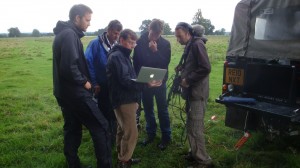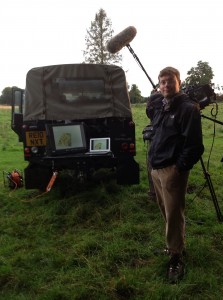 Dr Matthew Nicholls of the Classics Department uses digital technology to create reconstructions of the ancient past. He’s been working for some time on a huge digital model of ancient Rome, which he uses a lot for teaching and research. Students find these dramatic visualisations of the past engaging and useful, so Matthew has now developed a new module, CL3SIL Digital Silchester in which Reading undergraduates research and create their own virtual reconstructions of our local Roman town.
Dr Matthew Nicholls of the Classics Department uses digital technology to create reconstructions of the ancient past. He’s been working for some time on a huge digital model of ancient Rome, which he uses a lot for teaching and research. Students find these dramatic visualisations of the past engaging and useful, so Matthew has now developed a new module, CL3SIL Digital Silchester in which Reading undergraduates research and create their own virtual reconstructions of our local Roman town.
Matthew’s work lends itself well to television programmes on ancient Rome, and he has been in demand for programmes on Rome and its colourful history. Over the summer of 2012 the BBC contacted him to ask whether he could help with a documentary programme on Roman Scotland. The problem that programme makers faced was that while the story of the Romans in Scotland is fascinating, the archaeological remains they left behind often don’t show up well on the screen –  the forts and towns of the area, which never developed into settlements permanently occupied over centuries, often survive as bumpy fields rather than dramatic, easily-filmed standing ruins. The BBC decided they needed to create some computer graphics to represent these Romano-Scottish sites to the viewers, and asked Matthew to help.
the forts and towns of the area, which never developed into settlements permanently occupied over centuries, often survive as bumpy fields rather than dramatic, easily-filmed standing ruins. The BBC decided they needed to create some computer graphics to represent these Romano-Scottish sites to the viewers, and asked Matthew to help.
After an initial research trip at the start of the summer, Matthew returned to Reading and began work in the library, reading up on the history and archaeology of the sites chosen – the legionary fortress at Inchtuthil in Perth and Kinross, a fort with civilian settlement or vicus at Inveresk in East Lothian, a village of roundhouses at Birnie near Elgin, and a huge temporary marching camp at St Leonard’s.
 For the last of these only the outer earthwork survives, so Matthew turned to an ancient literary source, Pseudo-Hyginus, whose work on how to lay out the ideal Roman camp within those ramparts turns out to work pretty well for a camp of this size – an interesting combination of literary and archaeological evidence. For this part of the work Matthew was able to employ a second year undergraduate assistant as part of the University’s UROP scheme offering the student a fantastic chance to earn some money and CV points and to get his name on the credits of the finished documentary.
For the last of these only the outer earthwork survives, so Matthew turned to an ancient literary source, Pseudo-Hyginus, whose work on how to lay out the ideal Roman camp within those ramparts turns out to work pretty well for a camp of this size – an interesting combination of literary and archaeological evidence. For this part of the work Matthew was able to employ a second year undergraduate assistant as part of the University’s UROP scheme offering the student a fantastic chance to earn some money and CV points and to get his name on the credits of the finished documentary.
Matthew returned to Scotland at the end of the summer to film the use of these models on site, and then continued work on them to produce and render animations of the finished versions that were used in the finished documentary, Rome’s Final Frontier, broadcast in December 2012 The BBC kindly agreed to host some of the reconstructions online, providing a permanent resource for those interested in these fascinating sites.

